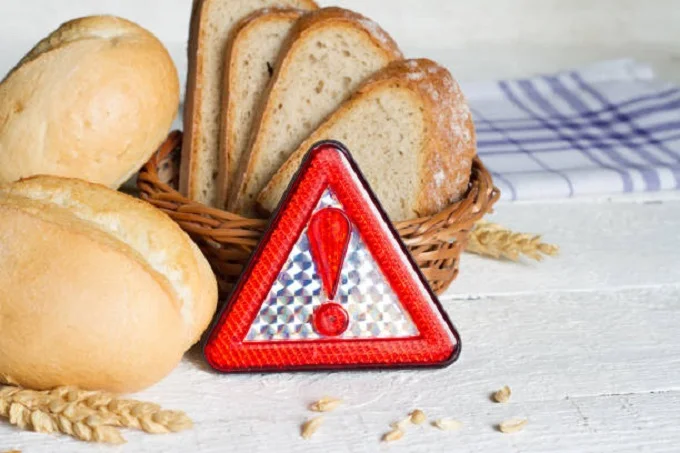The most common food intolerances and their symptoms

Food intolerance can occur in any of us but is more common in people with an increased allergic background. We may not even suspect that we have encountered intolerance and associate discomfort after eating with other reasons.
Food allergy and food intolerance are two different things. With allergies, our immune system perceives some food and environmental factors as hostile to us and triggers a defensive reaction. On the other hand, food intolerance is a reaction of the digestive organs to an ingredient that the body cannot absorb. The immune system is not involved in this reaction. Therefore, food intolerance symptoms are often milder than allergic symptoms and are more difficult to recognize. Let’s talk about the most common types of food intolerance and their symptoms.
What are food intolerances?
Food intolerances are associated with substances that are contained in food. This is another difference from allergies, which can occur due to external factors like dust or flowering plants. There are most common intolerances:
1. Lactose intolerance

Lactose intolerance, a type of sugar found in dairy products, is the most common type of food intolerance. To get the latest stories, install our app here
Depending on the extent of this condition, either a reduction in the amount of dairy products in the diet or complete elimination of any products containing lactose may be required
2. Lectin and alkaloid intolerance
Some plants contain special proteins called lectins. They participate in intercellular interactions and protect plants from pathogenic bacteria, fungi, and even animals. Alkaloids are organic alkalis also found in plants. Some people experience intolerance to these substances. Most of them are in the nightshade family: tomatoes, peppers, eggplants, and potatoes. Lectins are also found in legumes – beans, lentils, chickpeas.
3. Gluten intolerance

Gluten is a protein found in wheat, rye, and barley and their derivatives. Gluten intolerance is expressed in the digestive reactions of the body, unlike celiac disease. In the second case, the disease is manifested by a whole range of symptoms: joint pain, skin rash, vitamin deficiency, and anemia.
4. Histamine intolerance
Histamines are naturally occurring chemicals found in foods such as cheese, pineapples, bananas, avocados, and chocolate. Red wine and some white wines also contain these substances.
People with histamine intolerance do not produce enough of the enzyme diamine oxidase. The latter is needed to break down this chemical. To get the latest stories, install our app here
In any case, both with celiac disease and with gluten intolerance, it is worth eliminating certain foods from your diet. In addition to cereals, gluten is found in many processed foods, sausages, ready-made sauces, confectionery, chips, and other snacks.
5. Salicylate intolerance
Salicylates are natural chemicals found in various plant foods such as fruits, vegetables, herbs, and spices. Artificial flavorings and preservatives, such as those found in toothpaste, chewing gum, and sweets, are likewise high in them.
The majority of people can handle moderate levels of salicylates in their diet; however certain people have a lower tolerance.
Symptoms of food intolerance
We want to draw attention to the significant difference in the mechanisms of allergy and intolerance. With allergies, we experience unpleasant symptoms, regardless of the amount of the allergen. And with intolerance, the intensity of symptoms directly depends on the volume of the product eaten. Therefore, if you turn to a doctor and determine the optimal food norm for yourself that causes intolerance, you can not completely refuse your favorite dishes.
Here are the most common symptoms of food intolerance:
1. Bloating and gas
Excessive bloating and gas are among the most common symptoms. These same signs can occur, for example, if we eat foods rich in fiber. However, when bloating becomes painful and occurs every time we eat a certain food, it may indicate a food intolerance.
Such a reaction is often observed with lactose intolerance or the body’s inability to digest it fully. Additional symptoms include diarrhea. It can appear immediately or several hours after drinking milk, yogurt, or ice cream.
2. Abdominal pain

Abdominal pain can appear for various reasons and also manifest itself in different ways. Food intolerance is most often expressed in spasms. They appear in the lower and middle part of the abdomen immediately or within a short period after eating.
3. Heartburn
An unpleasant sensation of burning and squeezing that spreads from the abdomen to the throat is a symptom of food intolerance. Also, heartburn may be accompanied by a bitter or sour taste in the throat. It can last from several minutes to several hours. To get the latest stories, install our app here
4. Headache

Headaches are another sign of food intolerance. And in severe cases, food intolerances can even cause migraines.
Immunoglobulin G (IgG) antibodies are the most common type of antibody in the blood. When we eat something that our body considers a threat, it releases these antibodies into the bloodstream. Although this does not apply to all cases of intolerance, sometimes IgG antibodies can cause migraine and headaches.
5. Fatigue
After eating, we may feel tired, even if we were alert and full of energy before that. A spike in blood sugar levels may be to blame. However, sometimes feeling tired can be a sign of food intolerance.
When we eat foods that the body cannot digest, the adrenal glands release cortisol, the stress hormone. It helps fight irritation and inflammation. If fatigue occurs regularly, the cause is most likely a food intolerance.




